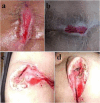Unroofing and curettage for recurrent sacrococcygeal pilonidal disease
- PMID: 39634483
- PMCID: PMC11614795
- DOI: 10.3389/fsurg.2024.1456846
Unroofing and curettage for recurrent sacrococcygeal pilonidal disease
Abstract
Purpose: Sacrococcygeal pilonidal disease (SPD) is a global concern, notably in Southeast Europe and the Middle East. Unroofing curettage (UC), which provides faster recovery, better cosmetic appearance, and lower recurrence rates in the primary cases, was evaluated with the results of recurrent disease.
Methods: This retrospective study included 74 patients with recurrent disease who were over 16 years of age, experienced recurrence after at least one surgical attempt, and underwent unroofing curettage between 2007 and 2019. Operation time, return to work duration, and recurrence rates were assessed.
Results: Mean age of patients was 29.8 ± 10.6 years, and 61 (82.4%) were male. Previous procedures included excision + flap reconstruction, excision + primary closure, and local excision + lay open. Mean operation time for unroofing curettage was 22 ± 5.3 min. Mean durations for return to work and recovery were 5.9 ± 3 days, and 6.5 ± 2.6 weeks, respectively. Mean follow-up duration was 81.6 ± 49 months. Recurrence was only observed in 1 (1.3%) patient. Unroofing curettage showed a mean recurrence-free period of 156.9 months (95% CI [, 152.9-160.9 months).
Conclusion: Unroofing curettage stands out as a low-recurrence approach, likely to persist as a treatment method, especially for a selected group with recurrence.
Keywords: curettage; pilonidal cyst; pilonidal sinus; recurrence; sacrococcygeal pilonidal disease; unroofing.
© 2024 Koc, Celasin, Sunter, Akyol and Gecim.
Conflict of interest statement
The authors declare that the research was conducted in the absence of any commercial or financial relationships that could be construed as a potential conflict of interest.
Figures




References
-
- Kuvvetli A, Çetinkunar S, Parlakgümüş A. Utility of methylene blue guided limberg flap on longterm recurrence in adult chronic pilonidal disease. Turkish J Color Dis. (2019) 29(3):118–20. 10.4274/tjcd.galenos.2019.93764 - DOI
LinkOut - more resources
Full Text Sources

